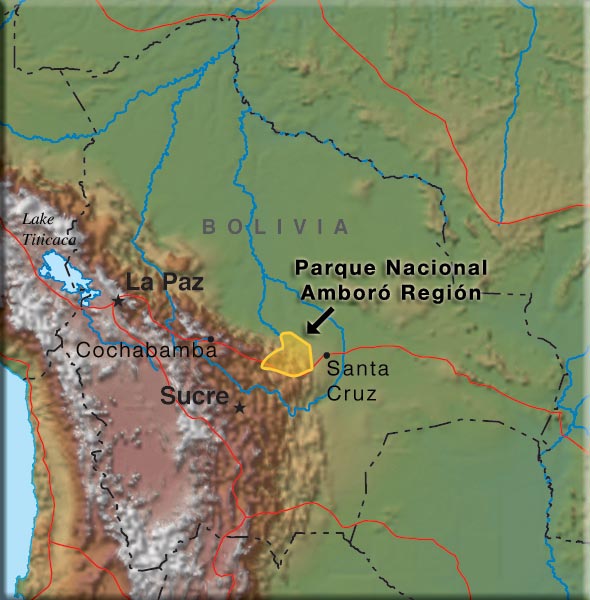The Park is located in and near the eastern limit of the Andes of central Bolivia, all in the Department of Santa Cruz and occupying parts of the provinces of A. Ibáñez, Florida, Ichilo and M. M. Caballero. It is situated approximately at 17°15'–18°05' S latitude and 63°30'–64°45' W longitude. The altitude varies from 235 meters above sea level in tropical evergreen rain forest along the northwestern border to 3100 meters in cool cloud forest on the highest peaks on the southwestern border. It is contiguous to the northwest with Parque Nacional Carrrasco in the Department of Cochabamba, and these two Parks contain the southermost section of the humid forests on the Andean front range. Amboró National Park had its beginnings in 1973 when a part surrounding Cerro Amboró was declared the “Reserva Natural Tcnl. Germán Busch”, and by 1984 this was converted to Parque Nacional Amboró with 180,000 hectares. Subsequent expansions and readjustments of the boundary have resultted in the current National Park which consists of 442,500 hectares, surrounded by 195,000 hectares of the buffer zone called the “Area Natural de Manejo Integrado Amboró” or the Amboró Natural Area of Integrated Management. The Flora includes all of this area plus some surrounding area bounded by the major highways from Santa Cruz, the “carretera antigua” or old highway on the south and the “carretera nueva” or new highway on the north.

Other sites about Amboró National Park:
Parque Amboro
Parque Nacional Amboró
Other links:
New York Botanical Garden
Questions or comments may be sent to Dr. Michael Nee, The New York Botanical Garden, Bronx, New York 10458-5126, U.S.A., or email: mnee@nybg.org.
This website is in part based upon work supported by the National Science Foundation under Grant No. DEB-0071701. Any opinions, findings, conclusions or recomendations expressed in this material are those of the author(s) and do not necessarily reflect the views of the National Science Foundation (NSF).
|